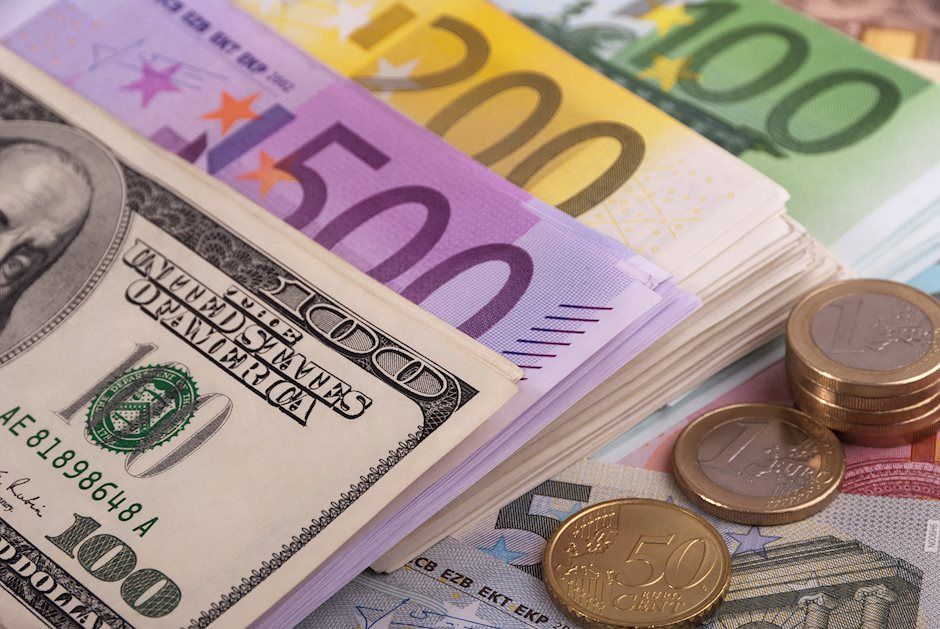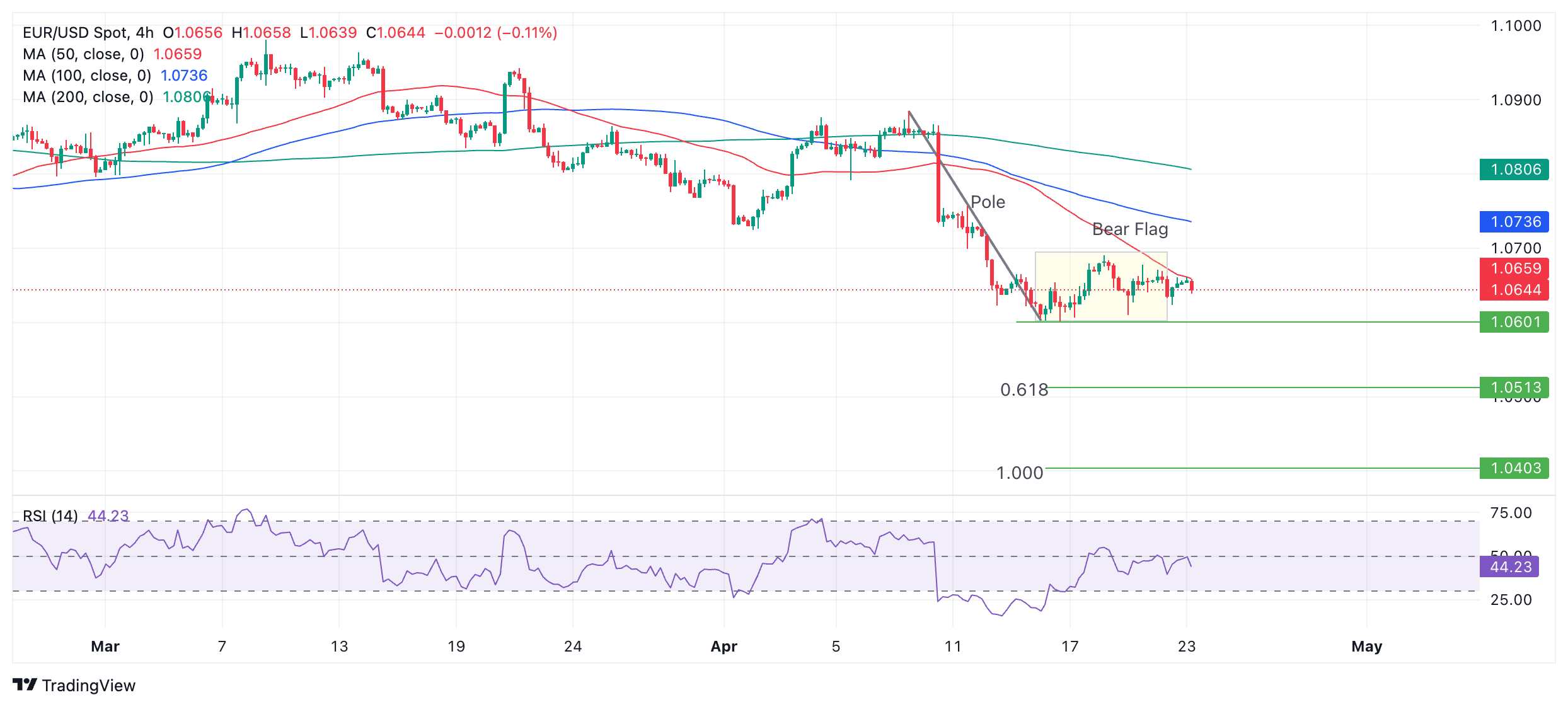Created
: 2024.04.23













![]() 2024.04.23 16:26
2024.04.23 16:26
EUR/USD extends its holding pattern of the last few days, trading in the mid 1.0600s on Tuesday, prior to the release of potentially market-moving purchasing manager survey data.
Preliminary Purchasing Manager Indexes (PMI) for April in both the United States and Europe are scheduled for release later in the day and could impact the exchange rate.
EUR/USD could potentially experience volatility after the release of HCOB PMIs for the Eurozone followed by S&P Global PMIs for America, during the US session.
The HCOB Composite PMI for the Eurozone is forecast to rise to 50.8 from 50.3 in March, the HCOB Manufacturing PMI to 46.5 from 46.1 and the HCOB Services PMI to 51.8 from 51.5.
The S&P Global Manufacturing PMI for the US in April is forecast to rise to 52.0 from 51.9 and Services to 52.0 from 51.7.
A PMI figure above 50 is indicative of growth in the sector; below 50 contraction. If any of the data show higher-than-expected readings, they could benefit the respective currencies and vice versa for lower-than-forecast results.
Of particular interest to currency traders will be Services PMIs since sticky inflation in the sector has been a major contributor to inflation, especially in the US.
Continued high inflation in the US is viewed as likely to keep interest rates relatively elevated in the United States compared to Europe. The expectation of higher borrowing costs for longer in the US has been bolstering the US Dollar (USD) since higher interest rates attract greater capital inflows.
In addition, later in the day, the US will also see the release of New Home Sales data for March and the Richmond Fed Manufacturing Index for April.
EUR/USD is trading in a rectangular range at roughly the same level as the 100-week Simple Moving Average (SMA).
Taken together with the steep decline that preceded the rectangle, the whole formation resembles a Bear Flag price pattern, which has bearish connotations.

A break below the 1.0601 April 16 low would signal a probable activation of the Bear Flag and the start of a decline.
According to technical lore, the expected move out of a Bear Flag usually equals the length of the "pole" or steep decline preceding the box-like formation of the flag square, or a Fibonacci ratio of the pole.
The Fibonacci 0.618 ratio of the pole extrapolated lower provides the most reliable conservative target. This gives a price objective at 1.0503. After that, the next concrete target is at 1.0446 - the October 2023 low. A fall of equal length to the pole would take EUR/USD down to 1.0403.
The Relative Strength Index (RSI) has exited oversold conditions, indicating renewed potential for more downside.
For bulls, resistance at around 1.0700 will need to be overcome to have any hope of recovery. After that, the April 2 swing low at 1.0725 provides the next upside target, followed by 1.0800, where a cluster of major Moving Averages coils.
The Euro is the currency for the 20 European Union countries that belong to the Eurozone. It is the second most heavily traded currency in the world behind the US Dollar. In 2022, it accounted for 31% of all foreign exchange transactions, with an average daily turnover of over $2.2 trillion a day. EUR/USD is the most heavily traded currency pair in the world, accounting for an estimated 30% off all transactions, followed by EUR/JPY (4%), EUR/GBP (3%) and EUR/AUD (2%).
The European Central Bank (ECB) in Frankfurt, Germany, is the reserve bank for the Eurozone. The ECB sets interest rates and manages monetary policy. The ECB's primary mandate is to maintain price stability, which means either controlling inflation or stimulating growth. Its primary tool is the raising or lowering of interest rates. Relatively high interest rates - or the expectation of higher rates - will usually benefit the Euro and vice versa. The ECB Governing Council makes monetary policy decisions at meetings held eight times a year. Decisions are made by heads of the Eurozone national banks and six permanent members, including the President of the ECB, Christine Lagarde.
Eurozone inflation data, measured by the Harmonized Index of Consumer Prices (HICP), is an important econometric for the Euro. If inflation rises more than expected, especially if above the ECB's 2% target, it obliges the ECB to raise interest rates to bring it back under control. Relatively high interest rates compared to its counterparts will usually benefit the Euro, as it makes the region more attractive as a place for global investors to park their money.
Data releases gauge the health of the economy and can impact on the Euro. Indicators such as GDP, Manufacturing and Services PMIs, employment, and consumer sentiment surveys can all influence the direction of the single currency. A strong economy is good for the Euro. Not only does it attract more foreign investment but it may encourage the ECB to put up interest rates, which will directly strengthen the Euro. Otherwise, if economic data is weak, the Euro is likely to fall. Economic data for the four largest economies in the euro area (Germany, France, Italy and Spain) are especially significant, as they account for 75% of the Eurozone's economy.
Another significant data release for the Euro is the Trade Balance. This indicator measures the difference between what a country earns from its exports and what it spends on imports over a given period. If a country produces highly sought after exports then its currency will gain in value purely from the extra demand created from foreign buyers seeking to purchase these goods. Therefore, a positive net Trade Balance strengthens a currency and vice versa for a negative balance.
![]()
Created
: 2024.04.23
![]()
Last updated
: 2024.04.23

FXStreet is a forex information website, delivering market analysis and news articles 24/7.
It features a number of articles contributed by well-known analysts, in addition to the ones by its editorial team.
Founded in 2000 by Francesc Riverola, a Spanish economist, it has grown to become a world-renowned information website.
We hope you find this article useful. Any comments or suggestions will be greatly appreciated.
We are also looking for writers with extensive experience in forex and crypto to join us.
please contact us at [email protected].
Disclaimer:
All information and content provided on this website is provided for informational purposes only and is not intended to solicit any investment. Although all efforts are made in order to ensure that the information is correct, no guarantee is provided for the accuracy of any content on this website. Any decision made shall be the responsibility of the investor and Myforex does not take any responsibility whatsoever regarding the use of any information provided herein.
The content provided on this website belongs to Myforex and, where stated, the relevant licensors. All rights are reserved by Myforex and the relevant licensors, and no content of this website, whether in full or in part, shall be copied or displayed elsewhere without the explicit written permission of the relevant copyright holder. If you wish to use any part of the content provided on this website, please ensure that you contact Myforex.
Myforex uses cookies to improve the convenience and functionality of this website. This website may include cookies not only by us but also by third parties (advertisers, log analysts, etc.) for the purpose of tracking the activities of users. Cookie policy